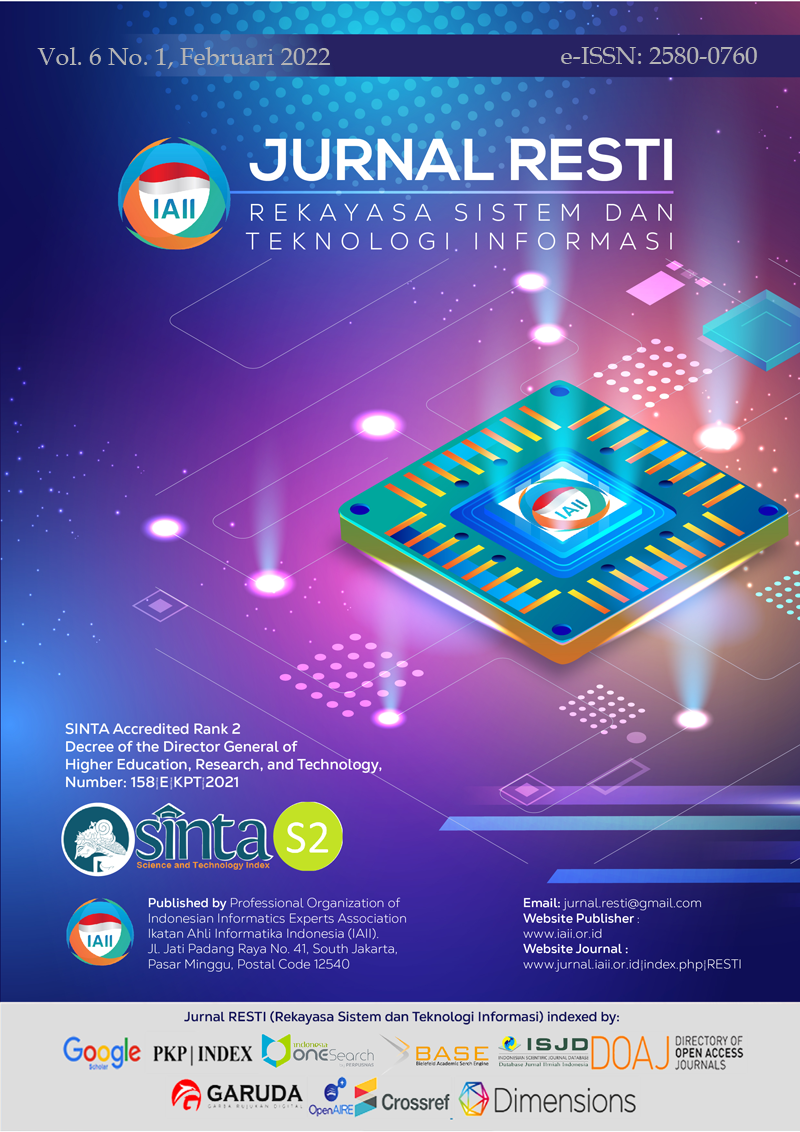Analisis Spasial Untuk Klasifikasi Pengembangan Tempat Penampungan Sementara Menggunakan Metode Jaringan Syaraf Tiruan
Spatial Analysis for Classification of Temporary Shelter Development Using Artificial Neural Network Method
Abstract
Garbage is a problem that needs an in-depth study in urban areas because the development of an area has consequences on increasing population density, facilities and infrastructure, public services, and other aspects that impact increasing the volume of waste. The distribution of temporary waste shelters (TPS) in each area is still insufficient to accommodate the volume of waste, and its availability is inadequate. The purpose of this study is to model spatial data through spatial analysis using artificial intelligence methods in classifying the development of integrated temporary shelter locations (TPST) and regional integrated temporary shelters (TPST Regions) by utilizing Web-based technology (Geographical Information System (Web-GIS). The Artificial Neural Network method with the Backpropagation algorithm is used for the spatial analysis process based on the parameters of the population, the amount of organic and inorganic waste, the amount of industrial waste, and the volume of the TPST and Regional TPST capacity. The spatial analysis results using the Artificial Neural Network method obtained an accuracy value of 7171.02%. The results of this study can be the basis for Department of Environment and Cleanliness policies for the development of TPST and TPST areas with information coverage at the village level.
Downloads
References
A. M. Menteri Hukum dan Hak Asasi Manusia Republik Indonesia, Undang-Undang Republik Indonesia Nomor 18 Tahun 2008. Jakarta, 2008.
M. S. Drs. Dwi Atmoko Sektiawan, MT; Anjarwati, S.Si, M.Env.; Asri Cahaya Hati, ST; Dian Angelia Sari, ST. ; Mufnaiti Prihartini, ST, MT.; Lintang Suska H., S.Si.; Arif Palupi Sandy, ST, MT,; Fery Indarto, ST.; Dian Tristi Agustini, ST.; Desy Gigih Pr, Dokumen Informasi Kinerja Pengelolaan Lingkungan Hidup Daerah Provinsi Jawatimur Tahun 2017. Surabaya: Dinas Lingkungan Hidup Provinsi Jawa Timur, 2017.
K. H. Darmawani, Ferry Sobatnu, Henyningtyas Suhel, “ESTIMASI VOLUME SAMPAH DOMESTIK DI KOTA Banjarmasin Menggunakan Sistem Informasi Geografis (Studi Kasus : Kecamatan Banjarmasin Selatan),” J. Positif, vol. 3, no. 2, pp. 88–92, 2017.
G. P. M. Spagnuolo, Heterogenous Spatial Data: Fusion, Modeling, and Analysis for GIS Applications. Morgan & Claypool, 2016.
H. J. Miller and E. A. Wentz, “Representation and spatial analysis in geographic information systems,” Ann. Assoc. Am. Geogr., vol. 93, no. 3, pp. 574–594, 2003.
M. G. Delgado and J. B. Sendra, “Sensitivity analysis in multicriteria spatial decision-making: A review,” Hum. Ecol. Risk Assess., vol. 10, no. 6, pp. 1173–1187, 2004.
K. A. dos S. Diogo Appel Colvero, Ana Paula Duarte Gomes, Luís António da Cruz Tarelho, Manuel Arlindo Amador de Matos, “Use of a geographic information system to find areas for locating of municipal solid waste management facilities,” Waste Manag., vol. 77, pp. 1–16, 2018.
R. S. M. L. Melinda Kimberley Pattisina, Linda Tondobala, “Analisis Pemilihan Lokasi Tempat Pembuangan Akhir (Tpa) Berbasis Geography Information System,” J. Spasial, vol. 5, no. 3, pp. 449–460, 2018.
S. N. Seyed Mohammad Hassan Erfania, Shahnaz Danesha, Seyed Mohsen Karrabia, Mohammad Gheibia, “Statistical analysis of effective variables on the performance of waste storage service using geographical information system and response surface methodology,” J. Environ. Manage., vol. 235, no. December 2018, pp. 453–462, 2019.
M. A. F. Amin Farahbakhsh, “Sustainable location and route planning with GIS for waste sorting centers, case study: Kerman, Iran,” Waste Manag. Res., vol. 37, no. 3, pp. 287–300, 2019.
B. T. S. Ercument Aksoy, “Geographical information systems (GIS) and Multi-Criteria Decision Analysis (MCDA) integration for sustainable landfill site selection considering dynamic data source,” Bull. Eng. Geol. Environ., vol. 78, no. 2, pp. 779–791, 2019.
D. L. H. dan K. K. Sidoarjo, Data Utama dan Data Tambahan Dokumen Informasi Kinerja Pengelolaan Lingkungan Hidup Daerah Kabupaten Sidoarjo 2018. Sidoarjo: Dinas Lingkungan Hidup Daerah Sidoarjo.
A. Vitianingsih, A. Choiron, D. Cahyono, A. Umam, and S. Suyanto, “Spatial Data Modeling on GIS for Classification of Measles-prone Region Using Multiple Attribute Decision Making,” Int. J. Intell. Eng. Syst., vol. 12, no. 3, pp. 97–107, 2019.
Badan Standarisasi Nasional, SNI Nomor 03 – 1733 – 2004 Tentang Tata Cara Perencanaan Lingkungan Perumahan di Perkotaan. Bandung: Badan Standarisasi Nasional, 2004.
M. E. S. Dr. Ir. Danis Hidayat Sumadilaga, Pedoman Teknis Pelaksanaan TPS 3R Tempat Pengolahan Sampah Reduce - Reuse - Recycle 2019. Jakarta: Kementerian Pekerjaan Umum dan Perumahan Rakyat, 2019.
M. K. T.Sutojo, S.Si., M. K. Edy Mulyanto, S.Si., and Dr. Vincent Suhartono, KECERDASAN BUATAN. SEMARANG: ANDI Yogyakarta, 2010.
S. Kusumadewi, Artificial Intelligence (Teknik dan Aplikasinya), Pertama. Yogyakarta: GRAHA ILMU, 2003.
R. R. W. Dyah Ayu Irawati, Ariadi Retno Ririd, “Implementasi metode trend moment untuk peramalan penjualan buku tulis,” ELTEK, vol. 10, no. 1, pp. 24–32, 2020.
H. R. Pourghasemi, A. Gayen, R. Lasaponara, and J. P. Tiefenbacher, “Application of learning vector quantization and different machine learning techniques to assessing forest fire influence factors and spatial modelling,” Environ. Res., vol. 184, no. February, p. 109321, 2020.
Copyright (c) 2022 Jurnal RESTI (Rekayasa Sistem dan Teknologi Informasi)

This work is licensed under a Creative Commons Attribution 4.0 International License.
Copyright in each article belongs to the author
- The author acknowledges that the RESTI Journal (System Engineering and Information Technology) is the first publisher to publish with a license Creative Commons Attribution 4.0 International License.
- Authors can enter writing separately, arrange the non-exclusive distribution of manuscripts that have been published in this journal into other versions (eg sent to the author's institutional repository, publication in a book, etc.), by acknowledging that the manuscript has been published for the first time in the RESTI (Rekayasa Sistem dan Teknologi Informasi) journal ;








